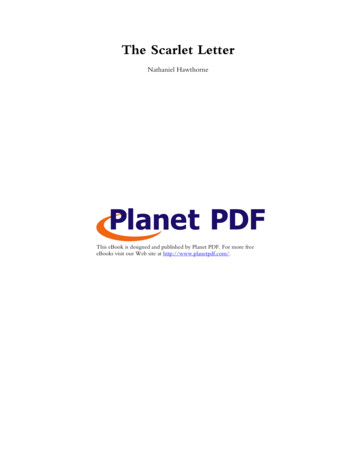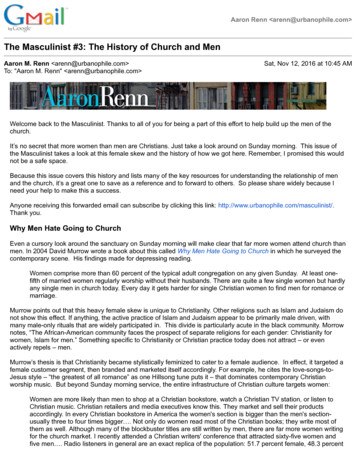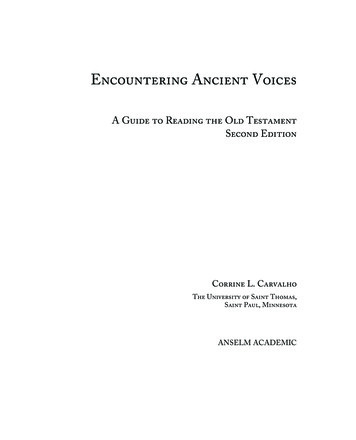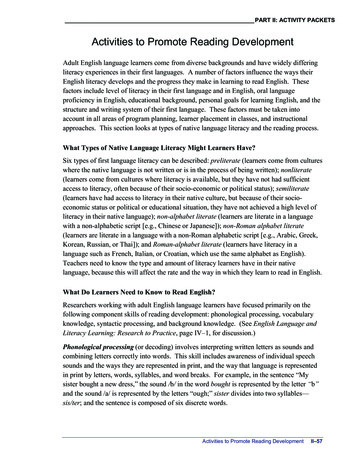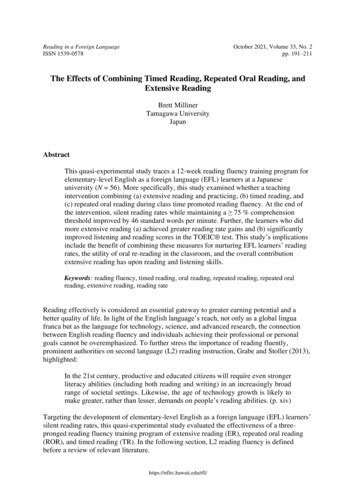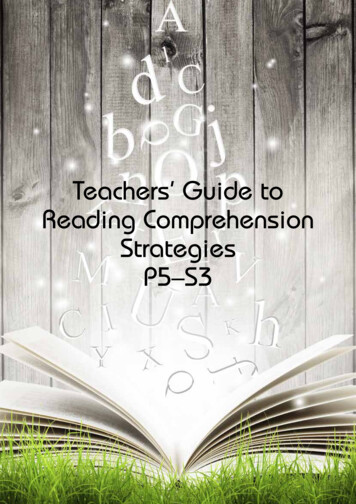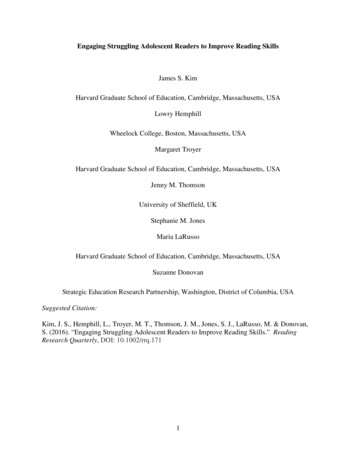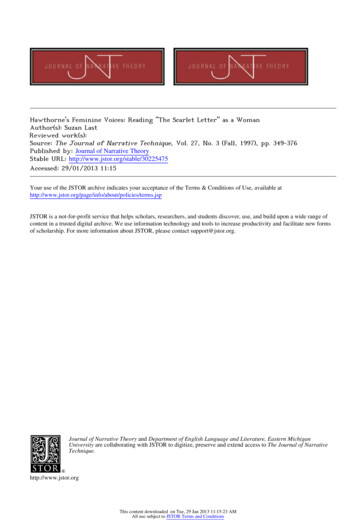
Transcription
Hawthorne's Feminine Voices: Reading "The Scarlet Letter" as a WomanAuthor(s): Suzan LastReviewed work(s):Source: The Journal of Narrative Technique, Vol. 27, No. 3 (Fall, 1997), pp. 349-376Published by: Journal of Narrative TheoryStable URL: http://www.jstor.org/stable/30225475 .Accessed: 29/01/2013 11:15Your use of the JSTOR archive indicates your acceptance of the Terms & Conditions of Use, available at ms.jsp.JSTOR is a not-for-profit service that helps scholars, researchers, and students discover, use, and build upon a wide range ofcontent in a trusted digital archive. We use information technology and tools to increase productivity and facilitate new formsof scholarship. For more information about JSTOR, please contact support@jstor.org.Journal of Narrative Theory and Department of English Language and Literature, Eastern MichiganUniversity are collaborating with JSTOR to digitize, preserve and extend access to The Journal of NarrativeTechnique.http://www.jstor.orgThis content downloaded on Tue, 29 Jan 2013 11:15:23 AMAll use subject to JSTOR Terms and Conditions
s a WomanSuzanLastA greatdeal of recentcriticismof NathanielHawthorne'sTheScarlet Letterhas focused on the two generalareasof narrativetheoryandfeminism.Feminist readingsof the novel have aboundedsince Nina Baym opened the subject up to debate in 1982 (Murfin282); and, whetherfeminist, materialist,psychoanalytic,deconstructionist-or any combinationof these and moremost critics devote considerablescrutinyto the "conflicted"and equivocalquality in the novel's narrativetechnique.'The narrator's"equivocal"stylehas inspired much critical speculationas to the novel's "underlyingideology," including debate over whetherthe novel is a seminal work of protofeminism orjust the opposite. Nevertheless,the equivocationin TheScarletLetteris not merelya dialecticof two contradictoryvoices; the narratorseemsto speak in many voices, to present multiple points of view, and to sharesympathieswith them alljust as muchas he revealsthemflawed. The lack ofa single guiding voice is, perhaps,what gave Mrs. Hawthorneher famousheadache.However,it is also the qualitythatmakesthe novel remarkableand, I would like to assert,remarkablyfeminine.Althoughthe narrativecontains many passages that characterisethe narratoras a championof patriarchal values, Hawthornealso makes use of what can be labelled "feminine"narrativetechniquesandstyles, with the effect of creatinga narrativeof radical sympathyfor women sufferingunderpatriarchaloppression.While all ofthe voices are not consistentin voicing this sympathy,the polyphonyof contradictoryvoices-both masculineand feminine-can, in itself, be labelleda femininetechnique,as it is inclusiveratherthanrestrictive.It includesmarginalisedperspectives and allows the reader a range of interpretationratherthan one unified, coherentand "authoritativetruth"in the text.This content downloaded on Tue, 29 Jan 2013 11:15:23 AMAll use subject to JSTOR Terms and Conditions
3501NTGendered Discourse?Let me acknowledge,before proceedingany further,that the distinctiondrawnbetween "masculine"and "feminine"discourse is entirely problematic, and necessarily artificial.The habit of binaryopposition in the sociolinguistic sphere has led to an identificationof non-genderedobjects andideas with eitherthe masculineor femininegender.In addition,the male halfof the binarypairhas been privilegedover its feminine counterpart,with theeffect of creatingassumptionsof "natural"male superiorityand female infe-becomesproblematic-indeed,it gliterature,for writingitself is consideredthe "feminine"halfof the speech/writingpairof binaryopposites.Whilefeministcriticshavebeenableto identifyanddefine"masculine"formsof discourse(easilydonesincetheyarethe ones thathavebeenrecommendedin defining"feminine"withoutever stoopingto vulgardefinitions,presentsthe "femininesentence"-throughexample-as one thatcannotbe limitedto a single perspectiveorthought,butinsteadleadsto multipledigressions.H6l1neCixousassuresus that,whileit maybe "impossibleto definea femininepracticeofwriting,"that "doesn'tmean thatit does not exist. But it will always surpassthe discourse that regulatesthe phallocentricsystem" (340). Many critics,nevertheless,have managedto make some defining observationsregardinggendereddiscourse.It is importantto keep in mindthatthese distinctionsareonly arbitrary,and necessarily artificial,based on social constructions,notbiology; silence, for instance, may be no more inherently"feminine"thansunlightis inherently"masculine,"except thatwe have been conditionedtothinkof it as so:MasculineDiscoursesman as subjectof languagespeech ddle-endone subjectperspectiveFeminineDiscourseswoman as subjectto languagewriting(Derrida)silence; semiotics"goes off in all directions"(Irigaray)intuition;streamof ther"or many perspectives(Woolf)This content downloaded on Tue, 29 Jan 2013 11:15:23 AMAll use subject to JSTOR Terms and Conditions
Hawthorne'sFeminineVoiceslinear progressof timeobjective/historicone meaning/logospublic351cyclical; "monumental"time (Kristeva)subjective;subversivepluralityof meaningprivateThis schema by no means provides a complete, or even adequate,list ofdistinctions.SusanLanser,for instance,cites "power"as anotherof the fundamentaldifferencesbetween "masculine"and "feminine"speech patterns:powerless(feminine)speechis "polite,emotional,enthusiastic,gossipy, talkative, uncertain,dull, chatty,"while powerful(masculine)speech is "capable,direct, rational,illustratinga sense of humor,unfeeling, strong (in tone andwordchoice) andblunt"(617). She argues,consequently,thatBakhtin'sconcept of polyphony,a multi-voicedqualityoperatingin all narratives,is "morepronouncedand more consequentialin women's narratives"(618). "Polyphonic"can easily describethe multiplevoices in the narrativeof TheScarlet LetterIf one follows JonathanCuller's suggestion and reads The Scarlet Letter"asa woman"-that is, resistingthe tendencyto "readas a man"2-femininediscoursesand techniquesseem to emerge from the novel in profusion.Myfirst reading of the novel was, perhaps,a "masculine"reading, as I foundthat the narrativegave me, as it is said to have given Mrs. Hawthorne,aheadache.The lack of consistency and coherence in voice and vision wasconfusing and even irritating.Only in a second-perhaps more "feminine"reading-did this perceived "lack"become rife with expression and meaning. This "feminine"readingreveals the many "feminine"characteristicsofthe narrative,and suggests-at the very least-the ambivalentattitudetowardspatriarchaloppressionof women displayedin the text, and possibly amuch more profoundsympathywith female oppressionthanis usually to befound in a male text. The multiplevoices presentmultipleperspectivesandideologies, or an anti-logos narrative, rejecting the possibility of onelogocentrictruthor one phallocentricview of history.The StingIn the bitinglyironic"Custom-House"sketch,the narrator(who mostof thesketch,if only ,or verylittlemore"[23]of TheScarletLetter)insinuateshimselffirmlyThis content downloaded on Tue, 29 Jan 2013 11:15:23 AMAll use subject to JSTOR Terms and Conditions
352JNTinto the historicalsettingof his "found"story.He implies thathe is NathanielHawthorne,author,and familiarto the readersthroughhis stories writteninan "old manse."He traceshis ancestryback to early Puritantimes, when hisforefatherswere communityleaders,not unlike those rulingover the Salemof Hester Prynne.While entrenchinghimself in this masculine world, he isalso distancinghimself from it, not only throughhis ironic descriptionsofthe "venerablepersonages"(52) of the custom-house,butthroughothernarrativetechniquesas well. The writingof TheScarletLetteritself is a distancing act, and he imagines the sternrebukeof his Puritanancestorsat his chosen vocation of story-telling(27). He chooses not to recorda "respectable"historyin truepatriarchalfashion-which he well mightdo, given the natureof the "authorizedand authenticated.,. document"he has found (44, emphasis added);nor does he choose to transcribethe heartilymasculinetalesof seafaringdirectlyfrom the sailorsfrequentingthe custom-house.Instead,he chooses to writea romance.In addition,he employs the conventionof the"foundstory,"a respectableliteraryconventionof the time, but in this casehis use of it can be takenfor little less thana patentlie, which undermineshisauthorityand reliabilityfrom the start.For in the same paragraphhe undermines his own convention when he admitsthathe has not confined himselfto Pue's "halfdozen sheets of foolscap,"but has allowed himself "nearlyoraltogetheras much license as if the facts hadbeen entirelyof my own invention" (44). This equivocationresults in a fundamentalproblemof reading:how is the readerto respondto the expectationscreatedby the use of genericliteraryconventions that are underminedby a narratoralmost in the samebreaththathe has constructedthem?While insisting on the authoritativehistoricityof his tale with one voice,he calls it a romancewith another.Because writingromanceswas not altogether a manly occupationin Hawthorne'sday, it is one that many moderncritics have come to regardas revolutionary.3Michael Davitt Bell, for instance, arguesthatto "indulgein the delusion of romancewas to underminethe basis of psychological and social order,to alienateoneself from [as Thomas Jeffersonso prosaicallyput it] 'thereal businessof life'" (37). A changein the political weatherhas resultedin the author/narratorbeing fired fromhis position withina frozenmasculineworldthathas effectively numbedhiscreativeside. The "wretchednumbness"resultingfromhis tenurein the custom-househas affectedhis creativityto the extentthathis characters"wouldnot be warmedandrenderedmalleable,by any heatthatI could kindle at myintellectualforge"(45). The politicaloustinghas enabledhim to rekindlehisThis content downloaded on Tue, 29 Jan 2013 11:15:23 AMAll use subject to JSTOR Terms and Conditions
Hawthorne'sFeminineVoices353imaginativefires. He rejectsthe masculinemilieu in orderto enterthe worldof imaginationand creativity.However,he abjuresthe more acceptable"realistic"form of the novel (ruledin his day by verisimilitude,or "probability"and convention),in favourof a form thathe saw as having more freedomtoindulge in the fantasticand marvelous,freedomto present"thetruthof thehuman heart"in a mannerof his own choosing. HeatherDubrow suggeststhat "if writing in a form that is not in vogue is a way of distinguishingoneself from the dominantliterarycultureof one's age, it can also be a wayof aligning oneself with a subculture,with the rebellioussons who are chalfathers"(13). Inthiscase, Hawthornemaybe aligninglengingthe authoritarianhimself with the rebelliousdaughters-the "scribblingwomen"(he calls himself a "scribbler"at the end of the CustomHouse sketch)-rather than withthe male novelists of his time. In telling the storyof the scarletletter,he haschosen to tell a woman'sstory;and in choosing a "feminine"formto presentit, he has adoptedwhathave come to be thoughtof as "feminine"techniques.This discussionof the CustomHouse sketch,nevertheless,remainsproblematic, for it leaves out a great deal of contraryinformationgiven by thenarrator.The most consistentcharacteristicof the narratoris thathe is rarelyconsistent on any topic. The story could never be mistakenfor a univocalmanifestoof proto-feminism.The narratordoes not simply rejectthe masculine milieu; he leaves it reluctantlyand somewhatbitterly,referringto himself as "decapitated"by the political powers that have ousted him from hismasculineprofession(and symbolicallycastratedhim). Janis Stout notes "in the narrative(234);but the conflict is expressedas more than a simple "duality."A multiplicityof conflicting voices oppositely and convergentlynarratethe story.In entering the "feminine" world of romance, the narratoragrees to give his"predecessor'smemorythe creditwhichwill be rightfullyits due"(44). SincePue's manuscriptis an obvious fiction, this vow may signal an intentiontoattendfaithfullyto historicalrepresentation.He vows, for instance,to be the"representative"of his Puritanancestors while writing his story (27). Headmits that "strongtraits of their naturehave intertwinedthemselves withmine."He wantsto take on their"shame,"andperhapsremove the cursethathas seemingly been laid upon them for theirceaseless oppressionof women(27). He wants to redresshistory's selective remembranceof Puritanseverity, andits neglect of their"betterdeeds, althoughthese were many"(27). Hecalls them "earnest"and "energetic";he appreciatesthe simplicity and seriousness of their morality(59); and he admirestheir attemptat creatingtheThis content downloaded on Tue, 29 Jan 2013 11:15:23 AMAll use subject to JSTOR Terms and Conditions
3541NT"new Jerusalem."This connection with his past has moved HenryJames tocomment on the narrator'srelationshipwith the Puritanheritage as it pervades the novel:Puritanism,in a word, is there, not only objectively,asHawthornetriedto placeit there,butsubjectivelyas well,notin anyharshnessofI mean,in hisjudgmentof his charactersprejudice,orin theobtrusionof morallesson;butin theveryqualityof his ownvision.(51)At the same time he incorporatesa "Puritanvoice" into his narrative,however, the narratoralso wants to acknowledgethe motivationsand feelings ofcharacterswho have sinned and brokenthe laws of this Puritancommunity.It is the juggling of the multiplevoices, perspectives,and ideologies thatmakes the narrativeof The Scarlet Letterspeak with a feminine sensibility.The narratormaintainsa constantpush-pullrelationshipwith his past, onemoment identifying with his patriarchalancestorsand co-workers,the nextcondemning them. This endless equivocationis the fundamentalnarrativetechnique used throughoutthe novel, as the narratorrarely states anythingfrequentlyallowing a varietyof interpretationsandpointsstraightforwardly,of view (two possible explanationsfor the existence of the rose bush [54];severalreasonsfor the popularityof Hester'sneedlework[77]; threereasonswhy Hester remainsin New England [75]; four explanationsfor the markson Dimmesdale's chest [197]; and innumerable "whether.or."con-structionsliberally pepperedthroughoutthe novel). His narrativeauthoritycertainly"goes off in all directions."If thereis an "authorial"phallogocentricvoice in the narrative,it is not the only-nor even the primary-voice of theomniscient narrative"truth."The many voices and perspectives allow formultipleandeven contradictoryinterpretations,as readerscan choose whichvoice they want to give "authority"or predominance,and which perspective, if any, holds a poetic "truth."The equivocationprominentin the narrationof TheScarlet Letterundermines the logocentricconceptof a singularmeaningandconfoundsa totalizing phallocentricinterpretation;in the logic of binaryopposition,this technique rests decidedly on the feminine side of the scale. Ignoringthe manymeta-discourseequivocationsin the Custom-Housesketch, the story itselfbegins with the narratorofferingus alternativeandheterodoxinterpretations.The narrator'scanonisationof Ann Hutchinsonat the opening of the storyThis content downloaded on Tue, 29 Jan 2013 11:15:23 AMAll use subject to JSTOR Terms and Conditions
Hawthorne'sFeminineVoices355revealsan unorthodoxinclinationfromthe start.He underminesthe ideaofwiththedescriptionof the"practicalnecessities"of thethePuritan"utopia"cemeteryand prison(53). At the doorof the prison-indeed, at the very"thresholdof our narrative"-weare given the imageof the rose bush,asymbolof beauty,contrastingwith the sterncolourlessnessof the Puritanof itslandscape.Weareallowedto chooseforourselveswhichinterpretationorigin we prefer:the supernaturalbelief thatit has sprungup underthe "foot-whichthenarratorassuresus "thereisstepsof thesaintedAnnHutchinson,"fair authorityfor believing,"or the more prosaicexplanationthat it "merelysurvivedout of the sternold wilderness"(54). Obviouslythe latteris thebutthenarratorseemsto preferthemorereasonableandlogicalexplanation;He urgesthereaderto do the samebyformer,moreromanticinterpretation.andby pluckingoneof theflowersfromtherosegivingit a "fairauthority,"bushandpresentingit to the reader,thatit mighteither"symbolizesomesweet moralblossom, thatmay be found along the track,or relieve the darkening close of a tale of humanfrailtyand sorrow"(54). This act, fraughtwithgendersignificance(as mentraditionallygive womenflowers),it couldbesaid, interpellatesthe readerto "readas a woman"andresistover-thematizingthe story in a masculinemanner.By favouringthe supernaturalreadingoverthe logical one, the suggestionin the opening passage of the narrativeprivileges a "poetic truth"of romanceratherthanhistoricalrealism, and a feminine perspectiveratherthan a masculineone.The "Problem" of InterpretationThe constantnarrativeequivocationpresentsobvious problemsfor interpretation-perhaps more clearly to recent critics steeped in the ambiguitiesof receptiontheory,feminism, deconstructionism,and postmodernambivalence, thanto Hawthorne'scontemporaries.Earlycriticswere not as eager torecognise the text's refusalto be interpretedin a singularway.The novel wasalternatelylauded and decried by those critics as a work of either supremedidacticism-whether pro or anti-Puritan--orcomplete immorality,"unfitfor the subjectof literature"(Brownson36). E. A. Duyckinck's great admiration for Hawthorne's"psychologicalromance"comes from its "moral,"which, "thoughsevere, is wholesome, andis a sounderbit of Puritandivinitythan we have been of late accustomedto hear from the degeneratesuccessors of CottonMather. The spiritof his old Puritanancestors,to whom herefers in the preface, lives in Nathaniel Hawthorne"(24-25). In contrast,This content downloaded on Tue, 29 Jan 2013 11:15:23 AMAll use subject to JSTOR Terms and Conditions
356J NTGeorge Bailey Loringfound thatthe tale "properlyexposed the inhumanityof Puritanism, which repressed the sensuous element in human nature"(Murfin207). GeorgeRipley,in his discussionof the novel's "moral,"comescloser to a modernperspectivein assertingthat"themoralof the story-forit has a moralfor all wise enough to detect it-is shadowedforthratherthanexpressed in a few brief sentences near the close of the volume" (26), but,perhapswisely, Ripley refrainsfrom specifying what this singular"moral"might be.The first critics mentionedseem to have heardonly the "public"voice ofthe narrator,the one seeking to be authorial,direct,and "illustratinga senseof humor."Perhaps,readingas men, they only heardthe masculinevoices inthe narrative.PerhapsRipley hearda more privatenarrativevoice, one underminingthatpublicstanceof masculineauthority.However,even thatpublicvoice was heardto speakcontradictorily-to which the opposing interpretations of Brownson and Duyckinck attest-indicating that the "voices" arenot limited to a simple oppositionof "public"and "private."The narratorisnot merelyjumping back and forthbetween his constrainedPuritanpersonaand a mid-nineteenth-centurymodem thinker.The focalizationis constantlyandprivatevoices and perspectives,as well asshifting among many publicamong the characters.In the opening scene of the novel, the narratorcreatesa point of view for himself throughthe "earlyseverityof Puritancharacter,"throughwhose perspective he imagines the many possible spectacles thatmight be beheld on the scaffold of early PuritanSalem (54). A few pageslater,the narratorimagines how a "Papist"might perceive the woman andchild on the scaffold, as an image of Divine Maternity,"butonly by contrast"since in this image was "the taint of deeper sin in the most sacredqualityof humanlife, workingsucheffect, thatthe worldwas only the darkerfor this woman's beauty,and the more lost for the infantthatshe had borne"(59). This harshjudgment seems straightforwardand "authorial"until oneremembersthatit is focalized throughthe pointof view of the "Papist."Thisdouble-voicedqualityobscuresthe intentof the statement.andperhapsmostpublic,voice-the one whichseemsIn his contemporary,most "authorial"-the narratortendsto generaliseandjudge weenpublicandprivatenarrativevoicesis based on the narrateeimplied by the voice. A privatenarrative,the traditionalareato whichwomenwriterswererelegated,positsa particularnarratee,usually in diary or letter form. The public voice hails a public audience. Itinhabitsthe same narrativelevel as the reader,and can often be seen as anThis content downloaded on Tue, 29 Jan 2013 11:15:23 AMAll use subject to JSTOR Terms and Conditions
er617). The narratorof TheScarletLetteradmirablyfits Lanser's descriptionof the public narratorwhen he adopts his authorialtendency to generalise andjudge. He speaks directlyto the implied reader,andbecomes overtly generalisingandjudgmentalwhen he characterizestheearly Puritanwomen as stronger,more solid and forceful, and even morebeautifulin their"substantial"way thantheirdescendants-his own femalecontemporaries(55). But in the scene that follows, he undermineshis ownauthorialperspectiveby allowing these "hardvisaged dames"to show themselves harsh, even shrewish, and certainly unattractivein their desire formore extreme punishmentof Hester than that decreed by the magistrates.One "autumnalmatron"assertsthat "atthe very least, they should have putthe brandof a hot iron on HesterPrynne'sforehead"(56). Anotherwoman,"the ugliest as well as most pitiless of these self-constitutedjudges," addsthat"thiswoman has broughtshameupon us all, andought to die" (56). Thenarratorrendershis own diegetic summaryof these women unreliablebypresentingthem mimeticallyas contradictinghis generalisationof early Puritanwomen.Monika Elbertcharacterizesthese post-menopausalwomen as mimicking the patriarchsof theircommunity.They areno longermaternal,andtherefore have no value in a patriarchalsystem, except whatthey can appropriatefor themselves as faux men. They have denied their gender,their maternalpower, and have no recoursein a patriarchalsociety but to adopt masculinepower: "These antagonisticwomen see Hester's sexuality in the way menconventionallyhave viewed it, as a threat"(175), and have dealt with thatthreatby "becomingmoremale,morehard,thanthe toughestpatriarch"(176).The only female voice thatspeaksout sympatheticallyfor Hesteris the youngmotherin the crowd.The unnamed,undescribed,unpresentedbut still present"Puritan"focalizer,whom the narratoroccasionally allows to speak throughhis narrativevoice, must feel some uneasiness before the heartlessnessofmany of the PuritanGoodwives aroundthe scaffold;for, indeed,the narratorhas a man in the crowd chastise the women for theirharshness:"Thatis thehardestword yet! Hush, now, gossips" (56). This anonymous"man in thecrowd"speaksfor the narratoron morethanone level: he silences the womenwho are underminingthe public narrator'sattemptto resurrectthe "betterdeeds"and more noble traitsof the Puritans;at the same time he is the sympathetic,yet socially orthodoxvoice thatcondemnsthe methodand severityof judgment,if not thejudgmentitself. As a characterandnot overt narrativeThis content downloaded on Tue, 29 Jan 2013 11:15:23 AMAll use subject to JSTOR Terms and Conditions
358JNTvoice, he is partof a mimetic-thus more "objective"-presentation of theharshnessof Puritanjudgment.Raising the "Fallen Woman" to a New ArtJanisStoutobservesthatthe novel's conflictedauthorialvoice challengesthe patriarchalstereotypeof the fallen woman and the Puritantreatmentofher, but never questions the reality of Hester's sin or guilt. She hears noironyor double-voicedqualitywhen the narratorspeaksof Hester'ssin, guiltand shame, and asserts that "howeverstronglyhe may deplore the narrowness and insensitivity of the self-righteousPuritansystem, he must chooselaw over the tracklesswildernessof moralchaos"(237). Althoughthe narrator seems to abhortheirmethods,he seems fundamentallyin agreementwiththe Puritanphilosophy,and thus, in Stout's view, he "cannotleave unchallenged the radicalsocial ideas he attributesto her"(238). Stout does not citea page numberor state specifically to which passage she is referring,but thefollowing excerpt seems to be an appropriateexample to highlightthe contreatmentof Hesterandherradicalism.flicted natureof the author/narrator'sIt is the strongest of several passages in which Hester voices passionate,unorthodoxopinions and feelings, and which the narratorconsistently follows with a seemingly negativejudgment.While the narrator'schallenge toHester's radicalsocial ideas may seem authorialbecause of theirplacementimmediatelyfollowing Hester'sthought-and, therefore,carrythe authorityof "thelast word"-these judgmentsarenot only ambiguous,butare heavilyoutweighed by the narrator'sassignmentof an eloquentpassion in the freeindirect-discourseblend of his and Hester'svoice (italics indicatingFID aremy ermind,withreferenceto the whole raceof womanhood.Wasexistenceworth accepting, even to the happiest among them?As con-cernedher own individualexistence,she had long ago decidedin thenegative,anddismissedthepointas settled.(134)Subsequentto this passage aboutHester'sinnerturmoil,the narratorprovides a generalisationabout women. It is writtenin the presenttense, making Hestera le readers to agree, while creating a kind of sympatheticunderstandingfor malereaders:This content downloaded on Tue, 29 Jan 2013 11:15:23 AMAll use subject to JSTOR Terms and Conditions
Hawthorne'sVoicesFeminine359A tendencyto speculation,thoughit maykeepwomanquiet,asit doesman,yet makeshersad.Shediscerns,it maybe suchahopelesstaskbeforeher.As a firststep,the wholesystemofsocietyis to be torndown,andbuiltup anew.Then,the verynatureof comelikenature,is to be essentiallymodified,beforewomancanbe allowedto assumewhatseemsa fairandsuitableposition.(134)This passage, commonly attributedto Hester,is quite clearly spoken by thenarrator;it is he who voices the radicalideas, in a profoundempathy withHester'sstateof mind,andwith the perception,as suggestedin the passage,ofwomen in general.He is addinghis own voice to her complaint-not in theambiguousformof freeindirectdiscourse,butplainlyin his "public"personagivingit the the revolutionarypassagefocuses not on Hester'sradicalideas, but on her ostitsregularandhealthyof mind;throb,wanderedwithouta clew in the darklabyrinthnowturnedasideby aninsurmountableprecipice;nowstartingbackfroma r,anda homeandcomfortnowhere.Attimes,a fearfuldoubtstroveto possesshersoul,whetherit werenotbettertosendPearlat onceto heaven,andgo herselfto etletterhadnotdoneits office.(134)Beginning with the word "thus,"the narratorsubsumeshis radicalsympathywith Hester undera generalguise of psychonarration-implyingthat he hasbeen merelypresentingHester'sthoughtsall along.The public "Puritannarrastatementof judgment,distor,"with a simple, if not exactly straightforward,avows the fragile sympathyhis alter("Other")ego created.This "public"persona aligns himself with the Puritanpatriarchalsystem in judging Hesternotonly as a sinnerbut as a revolutionary;but the moreprivateor subversivenarratorhas unquestionablyshownhis allegiancewithHester'sradicalism,even ifhe is conflictedaboutthe moralnatureof the "sin"thathelpedproduceit.This content downloaded on Tue, 29 Jan 2013 11:15:23 AMAll use subject to JSTOR Terms and Conditions
360JNTWhile severalcriticshave noted that"itis throughHester'svoice.,. thatHawthornespeaks as a revolutionary"(Martin128), an even more tangiblesubversionis enactedthroughHester's silence and non-verbalcommunication. The narrativecalls attentionto the "feminine"discourseof silence andgives it a power as greator greaterthanthe logos of patriarchy.Herrefusaltoname the fatherof her child confounds the leaders of the community.Thisrefusalto be boundto a "father,"even if beyond the laws of marriage,givesHestera greaterindividuality.She does not conformto an acceptablemodelof womanhoodthatreflects the man to whom she might belong; she belongsto no man in her community,and thus projectsher own meaning. She belongs to the communityas a whole-as the negativeexample,as the abjected,sin-infected "other"-but, in the eyes of the community,she is no man'swife, sister, mother,daughter.She is simply Hester Prynne, wearer of thescarletletter.The letterthey have "sentenced"herto wear attemptsto defineher as a transparentsign-as a transgressorof man's laws, if not as a lawfulreflectorof a man. The attempt,however, backfires-Hester's needle subverts the interpretivecode.ShariBenstock observes thatHester'sembroidery"makesa spectacle offemininity,of female sexuality,of all thatPuritanlaw hopes to repress"(289).Hester subverts the patriarchalsign by adding a non-linguistic femininesubtextto it, makingthe symbol standfor "woman."Patriarchallaw effectively defines woman as the "outlaw"or "other,"and withinpatriarchallanguage, she can rarely find the words to defend herself. In representing"woman,"Hester's sign does not simply brandwomen as "other,"but condemns patriarchyand its system of languagefor its inabilityto express a
Scarlet Letter as a Woman Suzan Last A great deal of recent criticism of Nathaniel Hawthorne's The Scarlet Letter has focused on the two general areas of narrative theory and feminism. Femi- nist readings of the novel have abounded since Nina Baym opened the sub- ject up to debate
